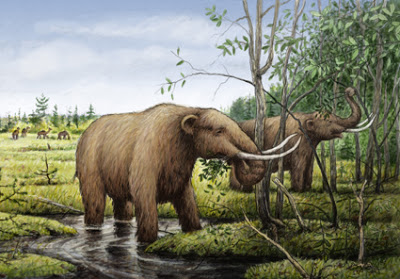
Early humans were the dominant cause of the extinction of a variety of species of giant beasts, new research has revealed.
Scientists at the universities of Exeter and Cambridge claim their research settles a prolonged debate over whether humankind or climate change was the dominant cause of the demise of massive creatures in the time of the sabretooth tiger, the woolly mammoth, the woolly rhino and the giant armadillo.
Known collectively as megafauna, most of the largest mammals ever to roam the earth were wiped out over the last 80,000 years, and were all extinct by 10,000 years ago.
Lewis Bartlett, of the University of Exeter, led the research, which also involved the universities of Reading and Bristol and is published in the journal Ecography. He said cutting-edge statistical analysis had helped solve the mystery almost beyond dispute, concluding that man was the dominant force in wiping out the creatures, although climate change could also have played a lesser role.
The researchers ran thousands of scenarios which mapped the windows of time in which each species is known to have become extinct, and humans are known to have arrived on different continents or islands. This was compared against climate reconstructions for the last 90,000 years.
Examining different regions of the world across these scenarios, they found coincidences of human spread and species extinction which illustrate that man was the main agent causing the demise, with climate change exacerbating the number of extinctions. However, in certain regions of the world — mainly in Asia — they found patterns which patterns were broadly unaccounted for by either of these two drivers, and called for renewed focus on these neglected areas for further study.
Lewis Bartlett, a researcher from the University of Exeter’s Centre for Ecology and Conservation, said: “As far as we are concerned, this research is the nail in the coffin of this 50-year debate — humans were the dominant cause of the extinction of megafauna. What we don’t know is what it was about these early settlers that caused this demise. Were they killing them for food, was it early use of fire or were they driven out of their habitats? Our analysis doesn’t differentiate, but we can say that it was caused by human activity more than by climate change. It debunks the myth of early humans living in harmony with nature.”
Dr Andrea Manica, of Cambridge University, was lead supervisor on the paper. He said: “Whilst our models explain very well the timing and extent of extinctions for most of the world, mainland Asia remains a mystery. According to the fossil record, that region suffered very low rates of extinctions. Understanding why megafauna in mainland Asia is so resilient is the next big question.”
Reference:
Lewis J. Bartlett, David R. Williams, Graham W. Prescott, Andrew Balmford, Rhys E. Green, Anders Eriksson, Paul J. Valdes, Joy S. Singarayer, Andrea Manica. Robustness despite uncertainty: regional climate data reveal the dominant role of humans in explaining global extinctions of Late Quaternary megafauna. Ecography, 2015; DOI: 10.1111/ecog.01566
Note: The above post is reprinted from materials provided by University of Exeter.










